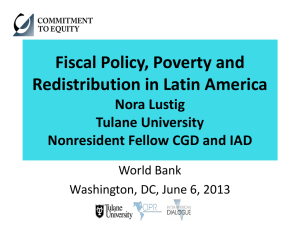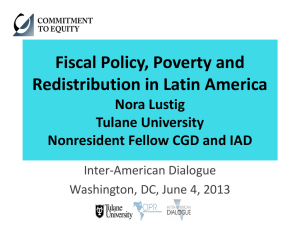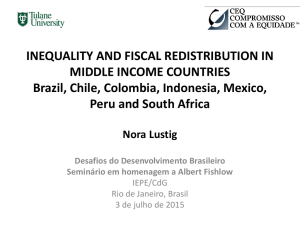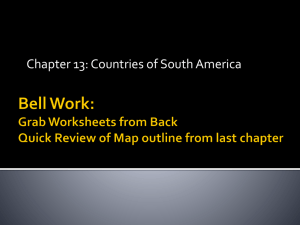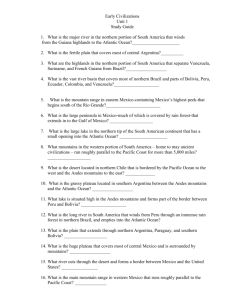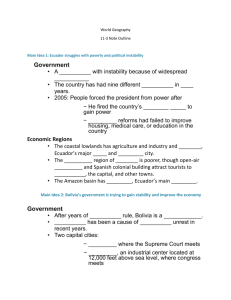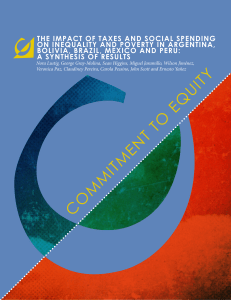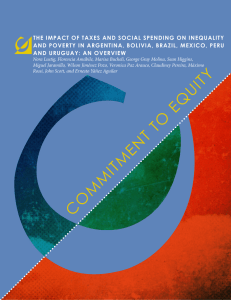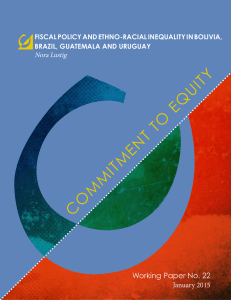Nora Lustig Tulane University CGD and IAD
advertisement
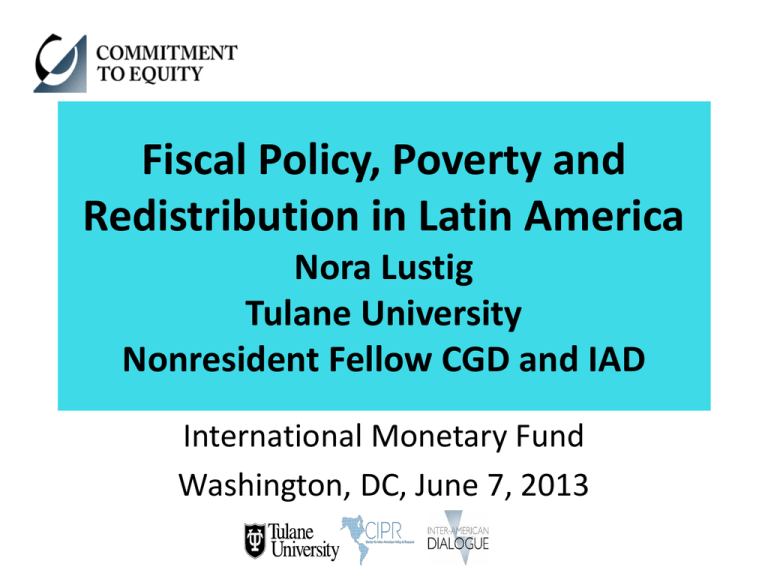
Fiscal Policy, Poverty and Redistribution in Latin America Nora Lustig Tulane University Nonresident Fellow CGD and IAD International Monetary Fund Washington, DC, June 7, 2013 Suppose you want to know… Assessment of current fiscal system or parts of it: • What is the impact of taxes and government transfers on inequality and poverty? • Who are the net tax payers to the “fisc” (with and without imputing benefits from in-kind transfers)? • How equitable is access to government education and/or health services? By income, gender, ethnic origin, for example. • How progressive is taxation and spending (as a whole and by categories)? 2 Suppose you want to know… Impact of hypothetical or actual reforms: • How do inequality and poverty change when you eliminate VAT exemptions? • Who benefits from the elimination of user fees in primary education or the expansion of noncontributory pensions? • Who loses from the elimination of energy subsidies? 3 Types of Incidence Analysis • Standard vs. Behavioral, CGEs, Intertemporal • Partial vs. Comprehensive • Average vs. Marginal 4 Welfare Indicator • Income vs. Consumption • Current vs. Lifetime • Per capita vs. equivalized 5 Basic elements of “applied” standard incidence Start with: • Pre-tax/pre-transfer income/consumption of unit h, or Ih • Taxes/transfers programs Ti • “Allocators” of program i to unit h, or Sih (or the share of program i borne by unit h) Then, post-tax/post-transfer income of unit h (Yh) is: Yh = Ih - ∑i TiSih 6 Allocation Methods Direct Identification in microdata If not in microdata, then: – (micro) Simulation: statutory vs. tax shifting or take-up assumptions – Imputation – Inference – Alternate Survey – Secondary Sources 7 Allocation Methods • • • • Tax shifting assumptions Tax evasion assumptions Take-up of cash transfers programs Monetizing in-kind transfers 8 Commitment to Equity Assessments (CEQ) for Latin America • Comprehensive standard fiscal incidence analysis of current systems • No behavior and no general equilibrium effects • Harmonizes definitions and methodological approaches to facilitate cross-country comparisons • Uses income per capita as the welfare indicator • Allocators vary => full transparency in the method used for each category, tax shifting assumptions, etc. • Mainly average incidence; a few cases with marginal incidence 9 www.commitmentoequity.org 10 • Special issue: Lustig, Pessino and Scott. Editors. “Fiscal Policy, Poverty and Redistribution in Latin America,”Public Finance Review (forthcoming) – Argentina: Nora Lustig and Carola Pessino – Bolivia: George Gray Molina, Wilson Jimenez, Veronica Paz and Ernesto Yañez – Brazil: Sean Higgins and Claudiney Pereira – Mexico: John Scott – Peru: Miguel Jaramillo – Uruguay: Marisa Bucheli, Nora Lustig, Maximo Rossi and Florencia Amabile 11 12 Contributory Pensions • Government transfer or market income? – No agreement in literature for pay as you go systems • CEQ Benchmark – Contributory pensions are part of market income – Contributions to pensions are not subtracted • CEQ Sensitivity Analysis – Contributory pensions are a government transfer – Contributions to pensions are subtracted like tax 13 Market Income • In addition to the uncontroversial wages and salaries, income from capital and private transfers (e.g., remittances), it includes: – Auto-consumption (with some exceptions) – Imputed rent for owner’s occupied housing – Contributory pensions from individualized accounts – Benchmark: Contributory pensions from social security 14 Net Market Income • Start with market income • Subtract direct taxes – individual income taxes – corporate taxes (when possible); NOT IN CURRENT VERSIONS – property and other direct taxes (when possible) • Subtract contributions to social security – Benchmark: contributions going to pensions are NOT subtracted; all the other contributions are – Sensitivity Analysis: all contributions to social security are subtracted • If survey reports after tax and cash transfers income, go backwards to construct net market and market income 15 Disposable, Post-fiscal, Final Income • Disposable income – Add direct transfers – Includes cash transfers and food transfers – Sensitivity analysis: pensions are a direct transfer • Post-fiscal income – Add indirect subsidies – Subtract indirect taxes • Final income – Add in-kind transfers from free or subsidized public services in education, health, housing – Currently, government cost method is used to value these services 16 Scaling Up • Household surveys understate “true” income – Underreporting – Lack of adequate questions – Society’s richest not captured by survey • HOWEVER, No scaling up for poverty measures (no corrections for underreporting) • Scaling up for inequality and distributional measures to avoid overstating impact of inkind transfers 17 Tax Shifting and Tax Evasion Assumptions • Burden of direct personal income taxes is borne by the recipient of income • Burden of payroll and social security taxes falls entirely on workers • Consumption taxes are assumed to be shifted forward to consumers • Individuals who do not participate in the contributory social security system assumed not to pay income or payroll taxes • Depending on the country, purchases in informal sector establishments or in rural areas assumed not to pay consumption taxes 18 Valuation of Public Services: Education and Health • Valuation of public spending on education and health followed is the so-called ‘government cost’ approach. • Uses per beneficiary input costs obtained from administrative data as the measure of marginal benefits. • This approach—also known as ‘classic’ or ‘nonbehavioral approach’—amounts to asking the following question: how much would the income of a household have to be increased if it had to pay for the free or subsidized public service at full cost? 19 Results • Wide variation among countries in terms of: – Policy choices (or outcomes of political processes?) – Impact of those choices on: • Income redistribution and poverty reduction • Progressivity of taxes and spending • Winners and losers; who bears the burden/benefits of taxes/transfers • Inequality of opportunity 20 Budget Size and Composition Primary and Social Spending as % of GDP 21 Gini Before and After Taxes, Transfers, Subsidies and Free Government Services 0.574 0.55 0.5 0.504 0.503 0.511 0.492 Argen na Gini 0.489 Bolivia 0.463 0.446 0.45 0.438 0.429 Brazil Mexico Peru Uruguay 0.4 0.393 0.369 Final Income Market Income 0.35 22 Gini Before and After Direct Taxes 0.574 0.563 0.55 0.511 0.492 Gini 0.5 0.504 0.503 0.503 0.498 0.497 0.478 0.45 Bolivia 0.463 0.438 0.446 0.429 Brazil Mexico Peru Uruguay 0.4 Final Income Net Market Income 0.35 Market Income 0.393 23 Direct and Indirect Taxes as % of GDP Direct Personal Income Taxes VAT and Other Indirect Taxes 12% 11% 8% 8% 4% 5% 0% Bolivia 2% 2% 1% Brazil Mexico Peru Uruguay 24 Headcount: Before and After Cash Transfers 25.00% 20.00% Argen na 15.00% Bolivia Brazil Mexico 10.00% Peru Uruguay 5.00% 0.00% Net Market Income Disposable Income 25 Coverage of Direct Cash Transfers 100.0% 90.0% 93.3% 87.7% 83.2% 80.0% 67.8% 70.0% 73.1% 57.7% 60.0% Poor<2.5 50.0% 41.9% 40.0% 2.5<=Poor<4 Non poor 29.2% 30.0% 20.0% 15.5% 10.0% 0.0% Bolivia Brazil Peru 26 Distribution of Direct Cash Transfers (Percent going to poor and nonpoor) 100% 90% 29.1% 80% 70% 62.0% 73.5% 60% 24.0% Non poor 50% 2.5<=Poor<4 Poor<2.5 40% 30% 12.8% 9.7% 20% 10% 46.9% 25.2% 16.8% 0% Bolivia Brazil Peru 27 Headcount Ratio Before and After Indirect Taxes 25.00% 20.00% Bolivia 15.00% Brazil Mexico 10.00% Peru Uruguay 5.00% 0.00% Net Market Income Disposable Income Post Fiscal Gini Before and After Government Services Valued at Cost 0.55 0.5 0.563 0.543 0.498 0.503 0.497 Gini 0.489 0.493 0.494 0.478 0.488 0.447 0.45 0.457 Argen na 0.463 Bolivia 0.446 0.438 0.429 Brazil Mexico Peru Uruguay 0.4 0.393 Final Income Disposable Income 0.35 Net Market Income 0.369 29 REDISTRIBUTION Tracking the Gini coefficient from Market to Final Income 0.574 0.563 0.543 0.55 0.541 0.511 0.492 Gini 0.5 0.504 0.503 0.503 0.498 0.497 0.494 0.493 0.488 0.501 0.489 0.481 Bolivia 0.478 0.45 0.457 0.459 0.463 0.446 0.438 0.429 Brazil Mexico Peru Uruguay 0.4 Final Income Post-fiscal Income Disposable Income Net Market Income Market Income 0.35 0.393 Defining Progressive/Regressive Taxes and Transfers 31 Progressivity Kakwani Index for Taxes: Red= regressive Direct Taxes Argentina na Bolivia ne Brazil 0.27 Mexico 0.25 Peru 0.43 Uruguay 0.25 Taxes Indirect Taxes na -0.20 -0.03 0.02 0.05 -0.05 All na -0.20 0.04 0.12 0.11 0.07 32 Progressivity Concentration Coefficients for Transfers Green= progressive in abs terms Social Direct Education Health Spending Transfers Argentina -0.31 -0.20 -0.23 -0.15 Bolivia -0.08 -0.02 -0.04 -0.04 Brazil 0.03 -0.16 -0.12 -0.08 Mexico -0.30 -0.09 0.04 -0.06 Peru -0.48 -0.17 0.18 -0.02 Uruguay -0.47 -0.11 -0.10 -0.16 33 Fiscal Incidence Indicators: Winners and Losers Who bears the burden of taxes and receives the benefits from cash transfers? • Fiscal incidence by decile and socio-economic groups • Fiscal Mobility and Degree of Impoverishment 34 Incidence of Taxes and Cash Transfers Net Change in Income after Direct and Indirect Taxes and Transfers by Decile 20% 15% 10% 5% Bolivia Brazil 0% Mexico 1 -5% 2 3 4 5 6 7 8 9 10 Peru Uruguay -10% -15% -20% 35 Fiscal Incidence of Income, Taxes and Transfers, by Socioeconomic Groups Market Income Population Shares PostFiscal Income BOLIVIA (2009) Poor (<$4) Vulnerable ($4-$10) Middle Class ($10-$50) Rich (>$50) Total population MEXICO (2008) 29.1% 38.8% 30.8% 1.3% 100.0% 4.0% -1.5% -1.9% -1.2% -1.4% BRAZIL (2009) Poor (<$4) Vulnerable ($4-$10) Middle Class ($10-$50) Rich (>$50) Total population Market Income Population Post-Fiscal Shares Income Poor (<$4) 23.8% Vulnerable ($4-$10) 38.0% Middle Class ($10-$50)35.3% Rich (>$50) 2.9% Total population 100.0% 12.3% -0.1% -8.3% -9.8% -6.1% PERU (2009) 26.7% 33.5% 35.3% 4.5% 100.0% 15.1% -7.1% -14.0% -20.7% -13.7% Poor (<$4) 28.6% Vulnerable ($4-$10) 37.5% Middle Class ($10-$50)32.0% Rich (>$50) 2.0% Total population 100.0% 3.4% -2.5% -9.9% -17.8% -8.5% 36 Impoverishment Fiscal Mobility Matrix for Brazil 37 CEQ WORKING PAPER SERIES http://www.commitmentoequity.org “Commitment to Equity Assessment (CEQ): Estimating the Incidence of Social Spending, Subsidies and Taxes. Handbook,” by Nora Lustig and Sean Higgins, CEQ Working Paper No. 1, July 2011; revised January 2013. “Commitment to Equity: Diagnostic Questionnaire,” by Nora Lustig, CEQ Working Paper No. 2, 2010; revised August 2012. “The Impact of Taxes and Social Spending on Inequality and Poverty in Argentina, Bolivia,Brazil, Mexico and Peru: A Synthesis of Results,” by Nora Lustig, George Gray Molina, Sean Higgins, Miguel Jaramillo, Wilson Jiménez, Veronica Paz, Claudiney Pereira, Carola Pessino, John Scott, and Ernesto Yañez, CEQ Working Paper No. 3, August 2012. “Fiscal Incidence, Fiscal Mobility and the Poor: A New Approach,” by Nora Lustig and Sean Higgins, CEQ Working Paper No. 4, September 2012. “Social Spending and Income Redistribution in Argentina in the 2000s: the Rising Role of Noncontributory Pensions,” by Nora Lustig and Carola Pessino, CEQ Working Paper No. 5, January 2013. “Explaining Low Redistributive Impact in Bolivia,” by Verónica Paz Arauco, George Gray Molina, Wilson Jiménez Pozo, and Ernesto Yáñez Aguilar, CEQ Working Paper No. 6, January 2013. “The Effects of Brazil’s High Taxation and Social Spending on the Distribution of Household Income,” by Sean Higgins and Claudiney Pereira, CEQ Working Paper No.7, January 2013. “Redistributive Impact and Efficiency of Mexico’s Fiscal System,” by John Scott, CEQ Working Paper No. 8, January 2013. “The Incidence of Social Spending and Taxes in Peru,” by Miguel Jaramillo Baanante, CEQ Working Paper No. 9, January 2013. “Social Spending, Taxes, and Income Redistribution in Uruguay,” by Marisa Bucheli, Nora Lustig, Máximo Rossi and Florencia Amábile, CEQ Working Paper No. 10, January 2013. “Social Spending, Taxes and Income Redistribution in Paraguay,” Sean Higgins, Nora Lustig, Julio Ramirez, Billy Swanson, CEQ Working Paper No. 11, February 2013. “High Incomes and Personal Taxation in a Developing Economy: Colombia 1993-2010,” by Facundo Alvaredo and Juliana Londoño Vélez, CEQ Working Paper No. 12, March 2013. “The Impact of Taxes and Social Spending on Inequality and Poverty in Argentina, Bolivia, Brazil, Mexico, Peru and Uruguay: An Overview,” Nora Lustig, Carola Pessino and John Scott, CEQ Working Paper No. 13, April 2013. 38 THANK YOU 39
